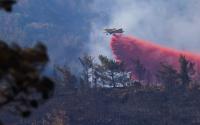3 October 2005Boston Globe / Environmental News Network
The environmental damage from hurricanes Katrina and Rita is unparalleled in its scope and variety, scientists say, with massive oil spills blanketing marshes, sediment smothering vast fishing grounds, and millions of gallons of raw sewage scattered in New Orleans and along the 400-mile Louisiana coast.The catastrophe extends from the heart of the Big Easy, where streets, sidewalks, and floors are coated with a thick mud mixed with human waste, to the fringe of protective marshland, sugarcane fields, and citrus groves along the Gulf Coast that are beginning to die from the sea's salty surge. Thousands of acres seem to have been swallowed forever by the ocean."This is an unprecedented event in terms of devastation and scale," said Harry Roberts, director of the Louisiana State University's Coastal Studies Institute. He says it will take time to fully evaluate the storms' impact. "It's not like a spill on a river or a beach; you have small channels, canals, towns, levees. Everything here is complicated . . . and it's not a simple environment to assess damage in."The scope of the cleanup ahead is most evident when seen from a plane. In a three-hour flight, a Globe reporter documented scores of examples of environmental damage from New Orleans 60 miles south: A shrimp boat, one of more than 100 observed tossed on roads and earthen levees, leaking a thin rainbow film of oil into the marsh. Two large white oil-storage tanks, one partially crumpled like a soda can, leaning precariously over the Mississippi River with remnants of its black goo smeared on a nearby beach. Boxcars, barges, and car ferries -- their contents oozing -- piled in canals and along the riverbank. Acres of marsh grass, beaten down by 100-mile-per-hour-plus winds and poisoned by salt water, turning brown.Nature is resilient, and most scientists agree that the Louisiana coast will recover, as it has after past hurricanes. Oil will evaporate, toxic compounds will be diluted, and fish will return. But it could take several years or longer, and by then fishermen, hunters, and farmers could be ruined, as duck hunting falls off because of the loss of wetlands, crawfish farms fail because of saltwater in ponds, and high salinity in the soil turns rice and cane fields barren. Finding new uses for the land could take years."It will always come back to some stable system; we'll have shrimp and oysters again . . . but the shock effect of the change and recovery time could be great," said Paul Coreil, vice chancellor for the Louisiana State University Agriculture Center.The most immediate concern is more than 8 million gallons of spilled oil in Louisiana -- a total that could grow significantly in coming days as Coast Guard officials continue to survey the spills. Just one Murphy Oil Corp. tank spilled 1.5 million gallons that mixed with sea water and washed into marshes, canals, sewers, and swimming pools over a square mile of the community of Chalmette, southeast of New Orleans. The Exxon Valdez -- until now considered the nation's worst environmental disaster -- poured 11 million gallons of oil into Alaska's Prince William Sound in 1989.Despite the bigger volume, the Valdez spill was easier to deal with, cleanup and environmental officials say, because it came from a single source and largely stayed in one place. In Louisiana, oil has been found seeping from pipes, tanks, and other containers at more than 48 locations. Floodwaters allowed some of it to mix with the contents of underground gas storage tanks and the hazardous contents of thousands of homes and schools, including asbestos, paint thinner, and bleach, complicating the cleanup.Near the oil spill in Chalmette, a thick sludge coats a cul-de-sac and the tread marks of cars that tried to escape its clutches are visible from 1,500 feet in the air. Katrina's storm surge picked up the Murphy Oil tank and pushed it 30 feet, buckling it and opening a leak. The neighborhood resembles a war zone from Katrina, with roofs blown off and sheds resting on their sides. Through it all, the sheen of oil snakes into canals and a marsh. Federal officials have classified the neighborhood as a "hot zone" -- making it off-limits as they try to scrub oil from sewage pipes and mailboxes, and decide whether the neighborhood is salvageable.So far, cleanup workers have siphoned or removed more than 2.5 million gallons of oil from marshes, canals, and land that spilled in the biggest leaks. Most of the oil, however, has evaporated or was carried out to the Gulf on Katrina's and Rita's retreating storm surge where it was broken up and diluted, and will eventually biodegrade. Given the circumstances, cleanup officials say, it was far better for the oil to go to sea than to get caught in sensitive marshland."It could have been much worse," said Charlie Henry, lead scientific adviser for the Katrina and Rita response for the National Oceanic and Atmospheric Administration Office of Response and Restoration. Fewer than 100 birds have been recovered with oil on them, according to a US Fish and Wildlife official, but assessments are not complete.One-hundred forty oil and gas platforms in the Gulf of Mexico were damaged by Katrina -- 43 severely, including some that floated away or sank. While oily sheens were reported in the Gulf after Katrina, the amount of oil from platforms and pipelines appears to be negligible, federal officials say. While rigs and pipelines have been reported damaged during Rita -- and some small amounts of oil spills -- no final numbers exist yet.Many Louisiana fisheries, which produce 15 percent of US seafood and 50 percent of the nation's oysters, are believed to be devastated. Katrina dumped a thick layer of sediment east of the Mississippi Delta that probably smothered oyster beds, and Rita did the same in the western part of the state. Brown and white shrimp that spawn offshore and move inland to live in marshes have had much of their habitat destroyed. Officials say they believe the worst is yet to come: Decaying organic matter that is being stirred up or washed into lakes and the Gulf will probably cause oxygen levels in the water to drop, killing off fish.In New Orleans, the mess could take years to scrub clean. Federal and state teams are fanning out across the city, looking to identify and plug up thousands of "orphan" 55-gallon drums and barrels that floated out of industrial facilities. The barrels, many with labels peeled off by wind and weather, litter banks of canals and warehouse sites. Worries about breathing in particles released from the muck on the streets eased with Rita's dousing, but as a dry-out occurs, federal officials are sampling air again while residents complain of coughing. More than 22 million tons of debris will have to be disposed of and workers are combing through streets trying to separate hazardous waste from regular debris."I'm a glass-is-half-full kind of person, and there is significant environmental impact," said Coast Guard Captain Frank Paskewich, the commander of the New Orleans District who is overseeing the oil spill cleanup. But he said many of the polluted areas have been contained, making them easier to scrub clean. "I am optimistic we are going to mitigate it."To see more of The Boston Globe, or to subscribe to the newspaper, go to http://www.boston.com/globe. Source: Knight Ridder/Tribune Business News






